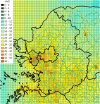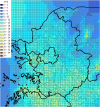1. Dockery DW, Pope CA, Xu X, Spengler JD, Ware JH, Fay ME, et al. An association between air pollution and mortality in six U.S. cities. N Engl J Med. 1993; 329:1753–9. DOI:
10.1056/NEJM199312093292401. PMID:
8179653.
2. Pope A, Thun M, Namboodiri M, Dockery DW, Evans JS, Speizer FE, et al. Particulate air pollution as a predictor of mortality in a prospective study of US adults. Am J Respir Crit Care Med. 1995; 151:669–74. DOI:
10.1164/ajrccm/151.3_Pt_1.669. PMID:
7881654.
3. Wilson R, Spengler J. Particles in our air: concentrations and health effects. 1996. Boston: Harvard University Press.
4. Holgate S, Samet J, Koren H, Maynard R. Air pollution and health. 1999. San Diego/London: Academic Press.
5. Zhang LW, Chen X, Xue XD, Sun M, Han B, Li CP, et al. Long-term exposure to high particulate matter pollution and cardiovascular mortality: a 12-year cohort study in four cities in northern China. Environ Int. 2014; 62:41–7. DOI:
10.1016/j.envint.2013.09.012. PMID:
24161381.
6. Katsouyanni K, Touloumi G, Spix C. Short-term effects of ambient sulphur dioxide and particulate matter on mortality in 12 European cities: results from times series data from the APHEA project. BMJ. 1997; 314:1658–63. DOI:
10.1136/bmj.314.7095.1658. PMID:
9180068.
7. Hong YC, Leem JH, Ha EH, Christiani DC. PM(10) exposure, gaseous pollutants, and daily mortality in Inchon. South Korea Environ Health Perspect. 1999; 107(11):873–8.
9. Brauer M, Amann M, Burnett RT, Cohen A, Dentener F, Ezzati M, et al. Exposure assessment for estimation of the global burden of disease attributable to outdoor air pollution. Environ Sci Technol. 2012; 46(2):652–60. DOI:
10.1021/es2025752. PMID:
22148428.
10. Ministry of Environment. Annual Report of Ambient Air Quality in Korea. 2012.
11. Ostro B, Sanchez J, Aranda C, Eskeland G. Air pollution and mortality: results from a study of Santiago, Chile. J Exp Anal Environ Epidemiol. 1996; 6:97–114.
12. Künzli N, Kaiser R, Medina S, Studnicka M, Chanel O, Filliger P, et al. Public-health impact of outdoor and traffic-related air pollution: a European assessment. Lancet. 2000; 356(9232):795–801. DOI:
10.1016/S0140-6736(00)02653-2. PMID:
11022926.
13. Byun, D.W. and J.K.S. Ching. Science Algorithms of the EPA Models-3 Community Multi-scale Air Quality (CMAQ) Modeling System, EPA Report, EPA/600/R-99/030, NERL, Durham: US EPA; 1999.
14. Carter WPL. Documentation of the SAPRC-99 Chemical Mechanism for VOC Reactivity Assessment, Report to California Air Resources Board, Contracts 92-329 and 95-308. 1999.
15. Guenther A, Karl T, Harley P, Wiedinmyer C, Palmer PI, Geron C. Estimates of global terrestrial isoprene emissions using MEGAN (Model of Emissions of Gases and Aerosols from Nature). Atmos Chem Phys. 2006; 6:3181–210. DOI:
10.5194/acp-6-3181-2006.
16. Pope CA III, Burnett RT, Thun MJ, Calle EE, Krewski D, Ito K, et al. Lung cancer, cardiopulmonary mortality, and long-term exposure to fine particulate air pollution. JAMA. 2002; 287:1132–41. DOI:
10.1001/jama.287.9.1132. PMID:
11879110.
17. Pope CA III. Respiratory hospital admissions associated with PM10 pollution in Utah, Salt Lake, and Cache Valleys. Arch Environ Health. 1991; 46(2):90–7. DOI:
10.1080/00039896.1991.9937434. PMID:
2006899.
18. Spix C, Anderson HR, Schwartz J, Vigotti MA, LeTertre A, Vonk JM, et al. Short-term effects of air pollution on hospital admissions of respiratory diseases in Europe: a quantitative summary of APHEA study results. Air Pollution and Health: a European Approach. Arch Environ Health. 1998; 53(1):54–64. DOI:
10.1080/00039899809605689. PMID:
9570309.
19. Wordley J, Walters S, Ayres J. Short term variations in hospital admissions and mortality and particulate air pollution. Occup Environ Health. 1997; 54:108–16.
20. Prescott GJ, Cohen GR, Elton RA, Fowkes FG, Agium RM. Urban air pollution and cardiopulmonary ill health: a 14.5 year time series study. Occup Environ Med. 1998; 55:697–704. DOI:
10.1136/oem.55.10.697. PMID:
9930092.
21. Poloniecki J, Atkinson R. Ponce de Leon A, Anderson H. Daily time series for cardiovascular hospital admissions and previous day's air pollution in London, UK. Occup Environ Health. 1997; 54:535–40.
22. Medina S, Le Terte A, Dusseux E. Evaluation des Risques de la Pollution Urbaine sur lar Sante (ERPURS). Analyse des liens a court terme entre pollution atmosherique et sante: resultats 1991-95. 1997. Paris: Conseil Regional d'lle de France.
23. Abbey D, Petersen F, Mills P, Beeson W. Long-term ambient concentrations of total suspended particulates, ozone, and sulfur dioxide and respiratory symptoms in a nonsmoking population. Arch Environ Health. 1993; 48:33–46. DOI:
10.1080/00039896.1993.9938391. PMID:
8452397.
24. Dockery D, Speizer F, Stram D, Ware J, Spengler J, Ferris BJ. Effects of inhalable particles on respiratory health of children. Am Rev Respir Dis. 1989; 139:587–94. DOI:
10.1164/ajrccm/139.3.587. PMID:
2923355.
25. Dockery D, Cunningham J, Damokosh A, Neas LM, Spengler JD, Koutrakis P, et al. Health Effects of acid aerosols on north American Children: respiratory symptoms. Env Health Perspect. 1996; 104:500–5. DOI:
10.1289/ehp.96104500. PMID:
8743437.
26. Braun-Fahrlander C, Vuille J, Sennhauser F, Neu U, Künzle T, Grize L, et al. Respiratory health and long-term exposure to air pollutants in Swiss Schoolchildren. Am J Respir Crit Care Med. 1997; 155:1042–9. DOI:
10.1164/ajrccm.155.3.9116984. PMID:
9116984.
27. Raaschou-Nielsen O, Andersen ZJ, Beelen R, Samoli E, Stafoggia M, Weinmayr G, et al. Air pollution and lung cancer incidence in 17 European cohorts: prospective analyses from the European Study of Cohorts for Air Pollution Effects (ESCAPE). Lancet Oncol. 2013; 14(9):813–22. DOI:
10.1016/S1470-2045(13)70279-1. PMID:
23849838.
28. Roemer W, Hoek G, Brunekreef B. Effect of ambient winter air pollution on respiratory health of children with chronic respiratory symptoms. Am Rev Respir Dis. 1993; 147:118–24. DOI:
10.1164/ajrccm/147.1.118. PMID:
8420404.
29. Segala C, Fauroux B, Just J. Short-term effect of winter air pollution on respiratory health of asthmatic children in Paris. Eur Respir J. 1998; 11:677–85. PMID:
9596121.
30. Gielen M, van der Zee S, van Wijnen J. Acute effects of summer air pollution on respiratory health of asthmatic children. Am J Respir Crit Care Med. 1997; 155:2105–8. DOI:
10.1164/ajrccm.155.6.9196122. PMID:
9196122.
31. Dusseldorp A, Kruize H, Brunekreef B. Associations of PM10 and airborne iron with respiratory health of adults living near a steel factory. Am J Respir Crit Care Med. 1995; 152:1032–9. DOI:
10.1164/ajrccm.152.6.8520758.
32. Hiltermann T, Stolk J, van der Zee S. Asthma severity and susceptibility to air pollution. Eur Respir J. 1998; 11:686–93. PMID:
9596122.
33. Neukirch F, Segala C, Le Moullec Y. Short-term effects of low-level winter pollution on respiratory health of asthmatic adults. Arch Environ Health. 1998; 53:320–8. DOI:
10.1080/00039899809605716. PMID:
9766476.
34. Abbey D, Hwang B, Burchette R. Estimated long-term ambient concentrations of PM10 and development of respiratory symptoms in a nonsmoking population. Arch Environ Health. 1995; 50:139–52. DOI:
10.1080/00039896.1995.9940891. PMID:
7786050.
35. Ostro B, Chesnut L. Assessing the health benefits of reducing particulate matter air pollution in the United States. Environ Res. 1998; 76:94–106. DOI:
10.1006/enrs.1997.3799. PMID:
9515064.
36. Leem JH, Jang YK. Increase of diesel car raises health risk in spite of recent development in engine technology, Environmental Health & Toxicology 2014;29. http://dx.doi.org/10.5620/eht.e2014009.
38. Jung KW, Park S, Kong HJ, Won YJ, Lee JY, Seo HG, et al. Cancer Statistics in Korea: Incidence, Mortality, Survival, and Prevalence in 2009. Cancer Res Treat. 2012; 44(1):11–24. DOI:
10.4143/crt.2012.44.1.11. PMID:
22500156.
39. McMichael A, Anderson H, Brunekreef B, Cohen A. Inappropriate use of daily mortality analyses to estimate longer-term mortality effects of air pollution. Int J Epidemiol. 1998; 27:450–3. DOI:
10.1093/ije/27.3.450. PMID:
9698134.
40. Abbey D, Nishino N, McDonnel W, Burchette RJ, Knutsen SF, Lawrence Beeson W, et al. Long-term inhalable particles and other air pollutants related to mortality in nonsmokers. Am J Respir Crit Care Med. 1999; 159:373–82. DOI:
10.1164/ajrccm.159.2.9806020. PMID:
9927346.
41. Baldi I, Roussillon C, Filleul L. Effect of air pollution on longterm mortality: description of mortality rates in relation to pollutants levels in the French PAARC Study. Eur Respir J. 1999; 24(suppl 30):S392.
42. Zemp E, Elsasser S, Schindler C, Künzli N, Perruchoud AP, Domenighetti G, et al. Long-term ambient air pollution and chronic respiratory symptoms (SAPALDIA). Am J Respir Crit Care Med. 1999; 159:1257–66. DOI:
10.1164/ajrccm.159.4.9807052. PMID:
10194174.
43. Kim SY, Lee JT, Hong YC, Ahn KJ, Kim H. Determining the threshold effect of ozone on daily mortality: an analysis of ozone and mortality in Seoul, Korea, 1995-1999. Environ Res. 2004; 94(2):113–9. DOI:
10.1016/j.envres.2003.09.006. PMID:
14757374.
45. Council NRD(NRDC). Breath taking: premature mortality due to particulate air pollution in 239 American cities. 1996. San Francisco: NRDC.
46. Son JY, Lee JT, Park YH, Bell ML. Short-term effects of air pollution on hospital admissions in Korea. Epidemiology. 2013; 24(4):545–54. DOI:
10.1097/EDE.0b013e3182953244. PMID:
23676269.
47. Park HY, Bae S, Hong YC. PM
10 exposure and non-accidental mortality in Asian populations: a meta-analysis of time-series and case-crossover studies. J Prev Med Public Health. 2013; 46(1):10–8. DOI:
10.3961/jpmph.2013.46.1.10. PMID:
23407325.
48. Kim YJ, Lee BE, Park HS, Kang JG, Kim JO, Ha EH. Risk factors for preterm birth in Korea: a multicenter prospective study. Gynecol Obstet Invest. 2005; 60(4):206–12. DOI:
10.1159/000087207. PMID:
16088197.
49. Kim E, Park H, Hong YC, Ha M, Kim Y, Kim BN, et al. Prenatal exposure to PM
10 and NO
2 and children's neurodevelopment from birth to 24 months of age: mothers and Children's Environmental Health (MOCEH) study. Sci Total Environ. 2014; 481:439–45. DOI:
10.1016/j.scitotenv.2014.01.107. PMID:
24631606.
51. Sommer H, Chanel O, Vergnaud JC, Herry M, Sedlak N, Seethaler R. Monetary valuation of road traffic related air pollution: health costs due to road traffic-related air pollution: an impact assessment project of Austria, France and Switzerland third WHO Ministerial Conference of Environment & Health. 1999. London: WHO.
52. Kunzli N, Kaiser R, Medina S, Studnicka M, Oberfeld G, Horak F Jr. Health costs due to road traffic-related air pollution: an impact assessment project of Austria, France and Switzerland. (Air pollution attributable cases. Technical report on epidemiology). 1999. Switzerland: Federal Department for Environment, Energy and Communications Bureau for Transport Studies.
53. Filliger P, Puybonnieux-Texier V, Schneider J. PM10 population exposure technical report on air pollution: health costs due to road traffic-related air pollution: an impact assessment project of Austria, France and Switzerland. 1999. London: WHO.







 PDF
PDF Citation
Citation Print
Print





 XML Download
XML Download